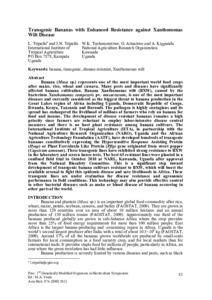| dc.contributor.author | Tripathi, L. |
| dc.contributor.author | Tripathi, J.N. |
| dc.contributor.author | Tushemereirwe, W.K. |
| dc.contributor.author | Arinaitwe, G. |
| dc.contributor.author | Kiggundu, A. |
| dc.date.accessioned | 2019-12-04T11:03:26Z |
| dc.date.available | 2019-12-04T11:03:26Z |
| dc.date.issued | 2013 |
| dc.identifier.citation | Tripathi, L., Tripathi, J. N., Tushemereirwe, W. K., Arinaitwe, G. & Kiggundu, A. (2011, September). Transgenic bananas with enhanced resistance against Xanthomonas wilt disease. In II Genetically Modified Organisms in Horticulture Symposium 974. Acta Horticulturae 974, 81-90. |
| dc.identifier.issn | 0567-7572 |
| dc.identifier.uri | https://hdl.handle.net/20.500.12478/1070 |
| dc.description.abstract | Banana (Musa sp.) represents one of the most important world food crops after maize, rice, wheat and cassava. Many pests and diseases have significantly affected banana cultivation. Banana Xanthomonas wilt (BXW), caused by the bacterium Xanthomonas campestris pv. musacearum, is one of the most important diseases and currently considered as the biggest threat to banana production in the Great Lakes region of Africa including Uganda, Democratic Republic of Congo, Rwanda, Kenya, Tanzania and Burundi. The pathogen is highly contagious and its spread has endangered the livelihood of millions of farmers who rely on banana for food and income. The development of disease resistant bananas remains a high priority since farmers are reluctant to employ labor-intensive disease control measures and there is no host plant resistance among banana cultivars. The International Institute of Tropical Agriculture (IITA), in partnership with the National Agriculture Research Organization (NARO), Uganda and the African Agriculture Technology Foundation (AATF), have developed hundreds of transgenic bananas constitutively expressing the Hypersensitive Response Assisting Protein (Hrap) or Plant Ferredoxin Like Protein (Pflp) gene originated from sweet pepper (Capsicum annuum). These transgenic lines have exhibited strong resistance to BXW in the laboratory and screen house tests. The best 65 resistant lines were planted in a confined field trial in October 2010 at NARL, Kawanda, Uganda after approval from the National Biosafety Committee. This is a significant step toward development of transgenic banana cultivars resistant to BXW, which will boost the available arsenal to fight this epidemic disease and save livelihoods in Africa. These transgenic lines are under evaluation for disease resistance and agronomic performance in field conditions. This technology may also provide effective control to other bacterial diseases such as moko or blood disease of banana occurring in other parts of the world. |
| dc.language.iso | en |
| dc.subject | Bananas |
| dc.subject | Transgenic |
| dc.subject | Xanthomonas Campestris |
| dc.subject | Musa |
| dc.title | Transgenic bananas with enhanced resistance against Xanthomonas wilt disease |
| dc.type | Journal Article |
| dc.description.version | Peer Review |
| cg.contributor.crp | Roots, Tubers and Bananas |
| cg.contributor.affiliation | International Institute of Tropical Agriculture |
| cg.contributor.affiliation | National Agricultural Research Organisation, Uganda |
| cg.coverage.region | Africa South Of Sahara |
| cg.coverage.country | Uganda |
| cg.coverage.country | Congo, Dr |
| cg.coverage.country | Rwanda |
| cg.coverage.country | Kenya |
| cg.authorship.types | CGIAR and developing country institute |
| cg.iitasubject | Banana |
| cg.journal | Acta Horticulturae 974 |
| cg.howpublished | Formally Published |
| cg.accessibilitystatus | Limited Access |
| local.dspaceid | 78068 |
| cg.identifier.doi | https://dx.doi.org/10.17660/ActaHortic.2013.974.9 |

